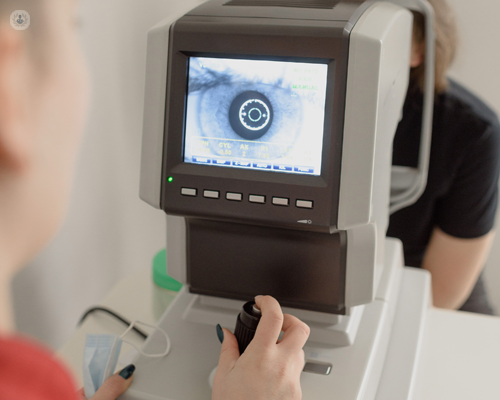On the whole, macular hole treatment is required
Written by:The effect that macular holes have on central vision can vary, and some small ones can fix themselves. However, it’s more common that central vision will degenerate rather than heal.
We speak to leading consultant ophthalmologist and vitreoretinal and cataract surgeon Ms Yvonne Luo to see how this deterioration can be treated.

What is a macular hole and what causes it?
If you think of your eye like a camera, so there's a lens at the front and a film at the back: the retina (the film of the camera) captures images and then sends it to the brain. The macular is the central part of the retina, where it captures images of the central vision. A macular hole by definition is a hole right in the centre of the macular. It's a bit like someone's punched out a hole in your central vision, in the film of the camera.
How does a macular hole occur?
The eyeball, the bulk of the eyeball, apart from the lens at front and the film at back, has a shield of a solid jelly that's called vitreous jelly. When we're young, it's nice, solid and clear, but when one gets older it naturally liquifies and breaks. They become floaters. In most people, it breaks without causing any problem. However, in a small number of people, the vitreous jelly is more strongly attached to bits of the retina at the back. So, when it breaks off, instead of making a clean break, it pulls on the retina and because the macular, the centre part, is the thinnest part of the retina, it literally punches a chunk of the retina out of it. That's what a macular hole is.
Is it a common condition?
It isn’t very common. It's one of the more common vitreoretinal conditions we deal with.
What symptoms will a patient experience? How is it detected?
The patient usually starts to feel a bit of distortion in the central vision and then as the pulling gets worse, then suddenly a crater forms in the central vision and everything around it distorts it. As time goes on, as the hole slowly gets bigger, you'll notice the centre of it gets bigger and bigger. About 30 per cent of people can have it in both eyes in five years.
It's important because lots of people don't notice it. We usually walk around with both eyes open and it's only when they rub on their eye, for example, they suddenly realise they can't see out of the other. Sometimes, unfortunately, it isn't diagnosed until quite a few months down the line. They haven't realised to cover one eye, and may have thought something isn't quite right and couldn't work it out. Sometimes, patients don't realise at all. They may find out by going for a routine eye test, and then told to cover one eye, which is when they notice: 'Oh, gosh, I couldn't see anything out of my other eye.' Unfortunately, some people don't notice it all for a very long time.
Is treatment always necessary for a macular hole?
Almost always for an established macular hole. So, when the hole is very small, less than 200 microns, there's probably about 50 to 70 per cent chance it could potentially close by itself. That's an exception rather than a rule. Most of the time, once it becomes a hole, it tends to get bigger.
It's not always necessary. There are a small number that close by itself, especially if it's very small, like less than 200 microns. The majority of the cases we see are much bigger than 200 microns; by the time the patient notices something is wrong, they come to us. Most of the time, macular hole treatment is necessary, but it's not always a necessary thing.
How is a macular hole treated?
It's treated by a surgery called vitrectomy, so you put three tiny key holes in the white part of the eye called the sclera. We go in, clear all of the jelly, get rid of all the pulling. Then you use a part of forceps to basically peel a very thin layer of scaffolding membrane right on the top of the retina. It's called internal limiting membrane. We peel a very thin layer of membrane off the surface layer of the retina. What that does is make the retina more mobile and then you put a gas bubble in eye. This bubble pushes against the retina and, because the retina is now more mobile, it comes in to close that gap.
Because the gas bubble rises, after the surgery we ask the patient to do what we call 'posturing'. So, they have to sit facing down so the bubble rises to push into the central vision. Depending on the size of the hole, it usually can just be overnight to three days for a medium-sized hole, or if it's a large hole then probably five days. That's my regime.
The chances of closing the hole are quite high, 9 out of 10 times it's successful. Your central vision, even if you close the hole, it will never be as good as before. It's because the middle bit has been pulled away. Obviously, the smaller the hole, the less you've lost in the first place and the better vision you can regain. In small holes, you can regain driving-level vision. But when the hole is big, unfortunately even if you close it, you don't see the gap anymore, you don't see a distortion. The clarity isn't as good as before.
The bigger the hole, the most tissue lost and the less vision you're going to get even if you close it. If you do have a macular hole, the sooner you get treated, the better the outcome.
Do you require expert ophthalmic assistance regarding macular holes? Ms Yvonne Luo can help. Visit her Top Doctors profile to arrange a consultation with this esteemed expert.


